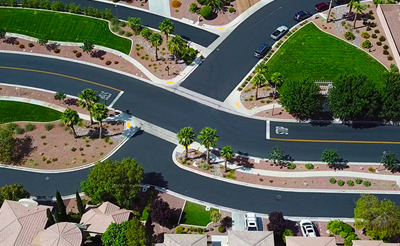
Two Causes of Street Deterioration You Can Prevent
By Mark Beatty / Published September 2023

Interestingly, what accelerates the deterioration of your community’s streets may not be what you’re thinking. High-volume traffic or a significant number of heavy trucks can certainly increase pavement stress that leads to road repair. However, when we focus on residential streets, there are accelerators of pavement distress that are much more easily combated if you don’t miss the window of opportunity. I’ll explain exactly what steps to take in this article.
Recently I visited one of the most notorious national parks in the country: the Grand Canyon. At times the canyon carved by the mighty Colorado River reaches over a mile in depth. What water can do is truly spectacular and geologically transforming. The process of erosion by water is slow but steady, as the river’s relentless flow carries sediments, sand, and debris, acting as a colossal chisel, meticulously sculpting the canyon’s steep walls and deep crevices. The sheer scale of the Grand Canyon serves as a reminder of water’s ability to shape and transform landscapes, reminding us of the profound impact that even seemingly gentle elements can have over time.
By comparison, the effects of water on asphalt pavement offer a glimpse into the immediate and more localized consequences of this powerful, natural element. While water may not carve canyons into the pavement, it can cause considerable damage, particularly when roads have not been maintained. When rain or landscape water seep into cracks and voids in the asphalt, it infiltrates the underlying layers, weakening the structure and leading to further degradation. Mitigating the harmful effects of water can be easily addressed if action is taken while the pavement is in good condition. I’ll speak to that momentarily.
Another challenge to roadways lies right in the nickname of the great state of Florida. That’s right, sunshine is another accelerant to deteriorating asphalt roads. If you ask a dermatologist about sun damage, they’ll often refer to the premature skin damage caused by the sun as photoaging. But here’s a new word you can throw out at your next board meeting that refers to the sun damage causing harm to your asphalt pavement—photooxidation.
 UV radiation from the sun can cause damage to asphalt pavements over time. As sunlight hits the pavement, it interacts with the asphalt binder, breaking down its molecular structure through a process called photooxidation. This leads to the gradual degradation of the asphalt, making it more brittle and susceptible to cracking and deterioration.
UV radiation from the sun can cause damage to asphalt pavements over time. As sunlight hits the pavement, it interacts with the asphalt binder, breaking down its molecular structure through a process called photooxidation. This leads to the gradual degradation of the asphalt, making it more brittle and susceptible to cracking and deterioration.
So now that we know that water and sun are accelerants that can wreak havoc on asphalt pavements with premature aging, what is the remedy? Traditionally, pavement sealers have been a “go to” for maintenance. There are various brands of surface treatments known as seal coats and rejuvenators that provide limited benefits. There are also surface treatments that are a little more durable, such as slurry or microsurface, but they leave behind a surface many residents find undesirable.
Research published by the former state pavement engineer for the California Department of Transportation found the use of a surface treatment classified as a High Density Mineral Bond, but commonly known as HA5, specifically reduced the impact of moisture and photooxidation with asphalt pavements. The research indicated that roads having HA5 installed experienced approximately a 67 percent delay in age hardening. It effectively worked to keep roads from getting brittle and becoming susceptible to cracking and deterioration.
Further research focused specifically on the ability of water intrusion on asphalt pavements. When HA5 was compared to surface treatments commonly used for the maintenance of municipality roadways, HA5 was determined to be 31 times less permeable than the next best performing surface treatment.
Returning to the examples of the effects of water creating the Grand Canyon and the premature aging of skin to due to excessive sun exposure—what is the driver of deterioration? It is regular exposure to these elements. When it comes to managing your pavement assets successfully, installing an effective preservation treatment needs to be done as early as possible before the damaging effects of the environment take their toll and shorten the useful life of the asphalt pavement.
Mark Beatty
Senior Vice President, Holbrook Asphalt Company
Mark Beatty is on the Advisory Board for the International Pavement Management Association and consults with public agencies and HOAs throughout the U.S. He is a sought-after presenter at public works events as well as HOA seminars. Mark serves as the Sr. Vice President at Holbrook Asphalt Company. You can contact Mark at mark@holbrookasphalt.com.




